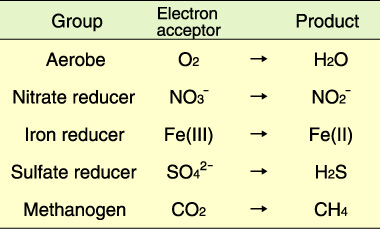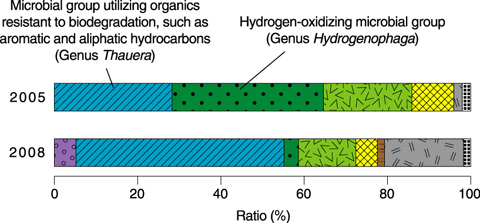Table 2-1 Major microbial metabolism types


Fig.2-11 Microbial composition of groundwater samples collected between 1148 and 1169 m underground in Toki granite
Recent studies have revealed that deep subsurface environments harbor many microorganisms, despite seeming to be too severe for organisms to survive. Understanding these microorganisms contributes to developing technologies and methods for evaluating subsurface environments. Organisms acquire energy using electron acceptors and electron donors. Human beings utilize, for instance, oxygen as an electron acceptor and organics as electron donors. Unlike surface environments, oxygen and organics are scarce in deep subsurface environments. Nevertheless, there appear to be various microorganisms that can utilize other electron acceptors and donors as energy sources (Table 2-1). Their energy acquisition rates depend on the coupling of electron acceptor and donor. In a limited energy source environment, microbial species that can sustain metabolic activity associated with a high rate of energy acquisition will adapt to the environment and dominate. Therefore, microbial composition shifts accompany a change in the chemical environment. This means that we could interpret the chemical environment transition by determining the microbial energy source and the shift in microbial composition. Few studies, however, describe the relationship of chemical environments to microbial compositions and metabolic activities in crystalline rocks.
In this study, we conducted geochemical analyses (anionic and cationic species, trace elements, organic acids, and dissolved gasses) of granitic groundwater collected in 2005 and 2008 from a depth segment between 1148 and 1169 m to determine the microbial energy source, as well as analyzing microbial composition and evaluating metabolic activities. Geochemical analyses showed that electron acceptors and organic acids, which are easily degradable by microorganisms, were scarce in the groundwater samples. The results of microbial composition analysis indicated that the microbial community was dominated by microorganism that could utilize organics resistant to biodegrading (Fig.2-11). Although concentrations of the main components did not change from 2005 to 2008, the hydrogen-oxidizing microbial group decreased. These results suggest that the hydrogen concentration in groundwater collected in 2005 (not measured) could be higher than in 2008, and thus indicate that there was a shift in the chemical environment. The exact cause of the shift is under investigation.
From these investigations, we were able to evaluate change in a deep subsurface environment that was assumed to be analogous to a geological disposal site.
This research was a collaborative project with the National Institute of Advanced Industrial Science and Technology (AIST).